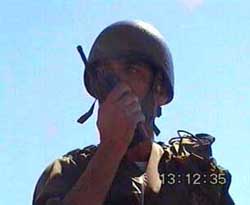



Just before I cross over from the Israeli to the Palestinian frontline, an Israeli Druze officer (pictured above left) radios the Palestinian liaison contact to coordinate a temporary Israeli ceasefire. This will enable the Palestinian police to - safely - go and try to remove the students from the scene.
It takes a few minutes for this process to begin, so as I'm walking down the left side of the road (pictured above right) swarms of rubber bullets pass by. The fly-by of the live ammunition earlier really did something strange to my sense of presence here. I'm flipping between being, on the one hand, unwilling to take even a minimal risk even though an interesting opportunity presents itself and, on the other hand, noting rubber bullets fly by in a very clinical, disconnected way whereas the reality is that to get hit by them could kill me.
As I realise this mental state isn't such a healthy one, I make a decision to consciously walk on the side of caution. It's not as if I'm getting paid big bucks to take any risks. Actually, it's not as if I am getting paid any bucks to take risks. The only publication I'm writing for now is Middle East International, which doesn't publish photographs. I'll probably write something for them about this if the clashes continue.
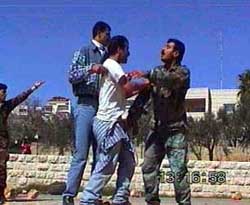
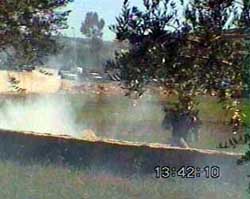
The Palestinian police make an attempt to push those at the front back. This is always a double-edged manoever, as the students know that throwing stones while their police are there means that the Israelis are discouraged from opening fire. No one wants another September 1996 clashes to errupt. One guy, above, is really cheesed off by what he sees as interference. He's shouting at the Israeli soldiers, "Mish zelamee!" ("You're not a man!").
He's telling the Palestinian police to mind their own business. It's a weird situation for them to have other Palestinians stop them from throwing stones. It's probably weird for the police as well. Unlike many of the other security organs, the police are made up of locals, many of whom would have themselves thrown stones at the Israelis in the past.
The Palestinian police are being pretty cool about it though, trying to wear down the demonstrators with reason and gentle restraint. They can't arrest the students, which would happen in another country if you stoned the police, because that would start major protests. The Palestinian police themselves don't think that throwing stones at the Israeli soldiers is any major or even minor crime.
I can safely say that the Palestinian police are of the opinion that it is completely understandable after the checkpoint shootings. But they are disciplined enough to follow the orders of their superiors and are therefore out here, trying to convince the students to pack it in. The tone of it is like, "Okay guys, you've thrown some stones, you've made the soldiers come out here in jeeps and journalists have recorded the protest. Now it's time to pack it in. There's no need for anyone to get hurt."
The guy pictured above is exhausted and gives up and goes to lie down and rest at the side of the road. The Palestinian police give up after a while as they recognise that the students have still got some energy left. They'll try again in the next hour or so. Meanwhile, the Israelis just need to keep the protesters at bay with the odd rubber bullet or teargas cannister until people get bored. They're not in any danger. One Israeli officer even says this to his men.
I photograph Kifah, who is looking after (30K, opens new browser) and helping to move the wounded (54K). Teargas seems to be the main problem, although a few people have been injured by rubber and plastic-coated metal bullets. One guy almost lost an eye from one. Women are getting hurt as well (47K).
In a sense, this is all the West Bank version of Janov's primal 'scream' therapy. It's cathartic, it makes the protesters feel some sense of accomplishment in a political situation where they are usually the losers. Israel gets a bit of unwelcome international press as these clashes draw attention to the original incident. But, ultimately, it makes very little difference to Israeli behaviour, although it does keep the issue in the news, which raises the possibility that the international community will, someday, act on that conscience thing. The Europeans and North Americans created this problem. It's high time they solved it.
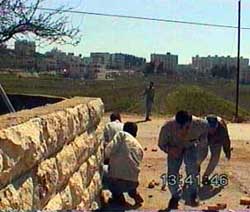
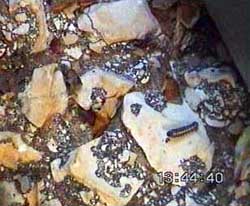
Crouching behind a wall I put on the gas mask. After a bad teargassing last spring during the Abu Ghnaim protests, after which I felt nauseous for a week, my tolerence to the stuff seems to be zero. I have no idea whether this is psychological or physiological. I am delighted to discover that the gas mask works.
A Palestinian demonstrator, not from Birzeit but visiting from Jericho, comes up to me to ask to borrow it, "just for a minute, so I can go and pick up that teargas cannister and throw it back at the Israelis." Myself and a Birzeit Gazan student friend talking to me laugh at him. "It's forbidden, man," says the Gazan, "He's a journalist. What are you thinking?! You want him to throw stones as well?!"
I must have knocked the record button on the video camera while running about. Later when playing the video back at the office, I find a couple of minutes' footage of the ground, with a caterpillar crawling slowly across the frame. You can hear me in the background making a phonecall to the office at the time, letting people know what was going on, and all the while this worm thing is making its way across the screen and this guy trying to convince me to lend him the gas mask.
"At the moment it's quiet, that's why I'm phoning you. You see, Adli phoned me earlier for an update when people were trying to stone me... No. No, I was just standing in the wrong place, near the soldiers. I was changing a film and didn't notice the solders had moved behind me until a stone hit my camera bag... No, man, it was funny. I couldn't stop laughing. I was trying to walk out of there sideways, holding the phone under my chin, with cameras in both hands. I must have looked really funny. Meanwhile Adli's asking me what is happening and I'm laughing too much to tell him..."
Other parts of the video sound like they've been shot by Darth Vader, the noise of my breathing through the gas mask in the background. The first time I've used a video camera at clashes, it is definitely recommended to Web publishers who need images for news stuff quickly. With a video capture card, you turn the video camera into a digital camera with a 40x zoom and almost unlimited shots to choose from.
The only drawback is if you are trying to take still pictures with a 35mm camera as well as the two tools require a completely different mindset. Video is all about rounded, representative coverage. Stills are all about the moment. Maybe I'll get used to it.
It's over. The Palestinian police move in and everyone's too tired to argue. I video a liaison officer from the Palestinian side going over to collect a satchel that was abandoned on what suddenly became the Israeli side after the gas station charge. He's going to return it to the student. The Israeli Druze officer says to the Palestinian policeman, smiling, "What? Your legs are tired? Were you throwing stones at us too?"
I walk home, stopping to buy a bottle of apple juice with the brand name "Fairuz". It's got gold tinfoil round the top so the fifty or so Palestinian police I have to walk by on the way to the main road think it's a beer and start laughing at me. Seeking a bit of peace and quiet, I start scraping the foil off and carry on along the dusty road home.
As I finish uploading this entry on 14 March 1998, I think about the fact that another two people went home the day after the shooting incident, the two Israeli soldiers that were detained out of the four that opened fire. Let's leave the last word to OC Central Command Maj.-Gen Uzi Dayan. Friday's Jerusalem Post reported that he:
"visited the paratroop unit at Tarkumiya junction. He reminded the soldiers that during the two years of his present command, not one soldier had stood trial for an incident that took place during operations."
You may remember in the first part of this entry that Dayan said, "The incident is a difficult one and is under examination." Elsewhere he and other Israeli politicians were reported as saying that a 'comprehensive' or 'thorough' investigation was underway, a detail reported with zeal by the international media.
It's amazing to think how efficient these Israeli investigating committees must be if they can come up with such a conclusive result after only 24 hours. It's like watching an episode of Homicide where every crime is solved in 45 minutes. Reality and television here have a lot more in common than we may often think.
>Arutz Sheva News Service >Friday, May 22, 1998 / Iyar 26, 5758 / 41 days to the Omer > SOLDIERS WHO KILLED IN SELF-DEFENSE WILL NOT BE CHARGED >The Army has decided to close the file on the three soldiers who were >involved in the deaths of the Arab workers in Tarkumiyeh. After over two >months of uncertainty, the three were informed yesterday that no charges >will be filed against them. On March 10, they were guarding a checkpoint >west of Hevron when a van carrying Arab workers suddenly increased its >speed and bore down upon them. The soldiers, thinking a terrorist attack >was underway, opened fire, killing three of the passengers. An IDF >investigation found that their actions were justified, as their lives >appeared to be endangered.